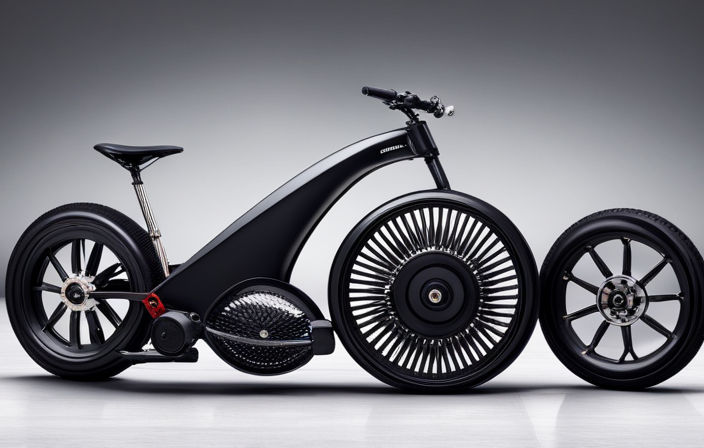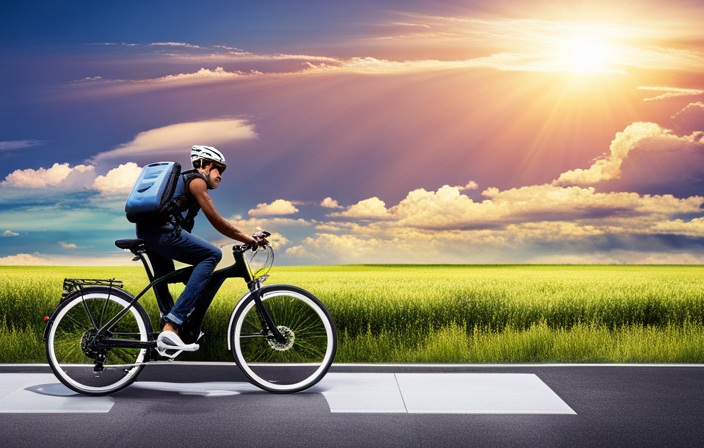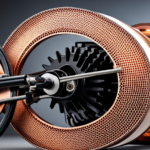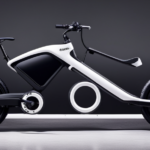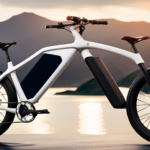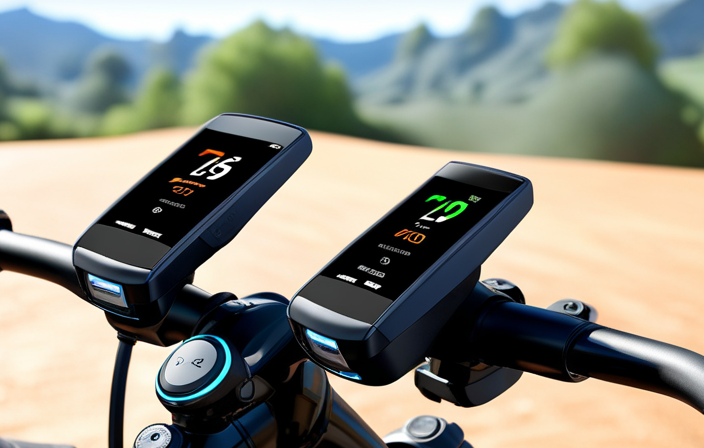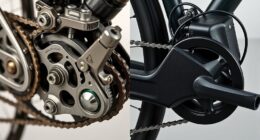Have you ever wondered how big of a motor you need for your electric bike? Well, look no further!
In this article, I will guide you through the process of understanding electric bike motors and help you determine the perfect motor size for your needs.
We will explore the factors to consider, different types of motors, power and performance, and even delve into the environmental and safety aspects.
So, let’s dive in and find the ideal motor size for your electric bike journey!
Key Takeaways
- Factors to consider when choosing a motor size for an electric bike include terrain, weight of rider and cargo, desired speed, battery capacity, and motor torque.
- There are different types of electric bike motors, including hub motors, mid-drive motors, and geared motors, each with their own advantages and placement on the bike.
- Motor power and performance, such as motor efficiency, torque, and acceleration, play a crucial role in the bike’s ability to climb hills, carry heavier loads, and achieve higher speeds.
- Matching the motor size to different types of riding, such as commuting, off-roading, or long-distance touring, is important to ensure optimal performance and efficiency.
Understanding Electric Bike Motors
To understand electric bike motors, it’s important to know the size of the motor you’ll need. The size of the motor is determined by factors such as battery capacity and motor efficiency.
Battery capacity refers to the amount of charge a battery can hold, usually measured in watt-hours (Wh). A larger battery capacity allows for longer rides and more power output from the motor.
Motor efficiency, on the other hand, is a measure of how effectively the motor converts electrical energy into mechanical energy. A more efficient motor will require less power from the battery, resulting in longer battery life and increased range.
When choosing a motor size for your electric bike, there are several factors to consider. One important factor is the terrain you will be riding on. If you plan on riding mostly on flat roads or smooth surfaces, a smaller motor might be sufficient. However, if you anticipate riding on hilly terrain or rough surfaces, a larger motor with more power would be necessary to provide the necessary torque and assistance.
Additionally, your weight and the weight of any cargo you plan on carrying should be taken into account. Heavier riders or those carrying heavy loads will require a more powerful motor to provide adequate assistance.
Factors to Consider When Choosing a Motor Size
When choosing the size of your motor, consider factors such as your desired speed and the terrain you will be riding on. The motor torque plays a crucial role in determining the power and performance of your electric bike. Higher torque allows for better acceleration and climbing ability, making it ideal for hilly terrains. If you plan on riding on steep hills or rough terrains, it is recommended to opt for a motor with higher torque.
Another important factor to consider is the battery capacity. The motor size should be compatible with the battery capacity to ensure optimal performance and range. A larger motor requires more power, which means a higher battery capacity is needed to sustain the ride for longer distances. It is essential to choose a motor and battery combination that provides sufficient power and range to meet your riding needs.
Transitioning into the next section about types of electric bike motors, it is important to understand that different motors offer varying levels of performance and features.
Types of Electric Bike Motors
When it comes to electric bike motors, there are three main types that you should be aware of: hub motors, mid-drive motors, and geared motors.
Hub motors are located in the wheel hub and provide direct power to the wheel, making them simple and low-maintenance.
Mid-drive motors, on the other hand, are placed in the middle of the bike frame and provide power to the crankshaft, resulting in better weight distribution and improved climbing ability.
Hub Motors
Hub motors are popular among electric bike enthusiasts because they offer a compact and efficient solution for powering the bike. When it comes to motor maintenance, hub motors are relatively low maintenance compared to other types of electric bike motors. The installation process for hub motors is also fairly straightforward, making it accessible for DIY enthusiasts.
To maintain the motor, it is important to regularly check for any loose connections or damaged wires. Additionally, keeping the motor clean and free from debris is essential for optimal performance. When installing a hub motor, it is crucial to ensure that it is properly aligned with the bike’s frame and securely attached.
With their simplicity and ease of maintenance, hub motors have become a popular choice among electric bike riders.
Transitioning to the next section about ‘mid-drive motors’, let’s explore another type of electric bike motor that offers its own unique advantages.
Mid-Drive Motors
To get the most power and efficiency out of your electric bike, consider using a mid-drive motor. Unlike hub motors, which are located in the wheel and can add weight and affect balance, mid-drive motors are situated near the bike’s crankshaft. This placement allows the motor to take advantage of the bike’s gears, resulting in improved torque and power delivery.
One of the key advantages of mid-drive motors is their ability to utilize the bike’s existing gear system. This means that the motor can operate at its most efficient RPM range, resulting in optimal power consumption. Additionally, because the motor is directly connected to the crankshaft, it can take advantage of the bike’s gearing to provide better hill-climbing capability.
| Advantages of Mid-Drive Motors |
|---|
| Improved torque |
| Better power consumption |
| Enhanced hill-climbing |
Now let’s move on to the next section, where we’ll explore another type of motor: geared motors.
Geared Motors
Geared motors, located near the bike’s crankshaft, offer improved power delivery and hill-climbing capability by utilizing the bike’s gears. These motors are designed to provide efficient power transfer from the motor to the wheels, making them ideal for electric bikes.
The gears in the motor allow for different torque requirements, allowing the rider to easily tackle steep inclines and challenging terrains. The motor efficiency is maximized through the use of gears, as they allow the motor to operate at its optimal RPM range. This means that the motor can deliver power more effectively, resulting in better overall performance and longer battery life.
Now, let’s delve into the next section and explore the important factors related to motor power and performance.
Motor Power and Performance
You’ll need to consider the motor power and performance when determining the size of the motor you need for your electric bike. The motor efficiency, torque, and acceleration are important factors to consider in this process.
Here are four key points to help you understand the relationship between motor power and performance:
-
Motor Efficiency: Efficiency refers to how effectively the motor converts electrical energy into mechanical energy. A higher efficiency motor will provide better power output and longer battery life.
-
Torque: Torque is the rotational force produced by the motor. It determines the bike’s ability to climb hills and carry heavier loads. A higher torque motor will offer better performance in challenging terrains.
-
Acceleration: Acceleration is the rate at which the bike can increase its speed. A more powerful motor will provide quicker acceleration, allowing you to reach higher speeds in less time.
-
Power Output: The power output of the motor is measured in watts. Higher power output means more power available for the bike’s performance.
Considering these factors, you can now make an informed decision on the size of the motor that best suits your needs. By matching the motor size to your requirements, you can ensure optimal performance and an enjoyable electric biking experience.
Matching Motor Size to Your Needs
When it comes to electric bikes, there are several key points to consider for different types of riding.
For commuting and city riding, having a motor size that provides enough power for quick acceleration and maintaining speed is crucial.
Off-roading and mountain biking require a motor that can handle rough terrains and provide sufficient torque for climbing steep hills.
Lastly, for long-distance touring, a motor with a larger capacity and a longer range is recommended to ensure a comfortable and efficient ride.
Commuting and City Riding
For commuting and city riding, your electric bike motor should be powerful enough to handle stop-and-go traffic and inclines. You want a motor that can provide you with enough torque to accelerate quickly and maintain a steady speed in urban environments.
When considering the size of your motor, you should also take into account the weight of any bike accessories you may be carrying, as this can affect the overall performance of your electric bike. Additionally, advancements in battery technology have made it possible to have smaller and lighter motors that still deliver impressive power. This means you can have a more compact and efficient motor without sacrificing performance.
Now, let’s move on to the next section about off-roading and mountain biking, where the demands on your electric bike motor are quite different.
Off-Roading and Mountain Biking
Transitioning from the previous subtopic of commuting and city riding, let’s now explore the world of off-roading and mountain biking with electric bikes. When it comes to tackling challenging terrains and steep inclines, having a motor with sufficient power is crucial for optimal off-road performance. Additionally, motor durability becomes a key factor as it needs to withstand the rigors of rough terrain and constant vibrations. To help you understand the motor requirements for off-roading, I have prepared a table that compares the motor power and durability for different types of electric bikes:
| Electric Bike Type | Motor Power (Watts) | Motor Durability |
|---|---|---|
| Mountain Bike | 750-1500 | High |
| Fat Bike | 1000-2000 | Very High |
| Enduro Bike | 1500-3000 | Extreme |
As you can see, off-road electric bikes require higher motor power to tackle challenging terrains. Additionally, the motor durability needs to be high to ensure longevity and reliability. Now, let’s move on to the next section and explore the world of long-distance touring with electric bikes.
Long-Distance Touring
Exploring the world of long-distance touring with e-bikes brings a sense of freedom and adventure to your travels. When embarking on these journeys, it is important to consider the battery capacity and charging infrastructure of your electric bike.
Long-distance touring requires a battery with sufficient capacity to cover the desired distance without frequent recharging. Look for e-bikes with larger battery capacities, such as those with 500Wh or higher, to ensure you have enough power for extended rides.
Additionally, it is crucial to research and plan your route in advance, taking into account the availability of charging stations or accommodations with charging facilities. This will allow you to recharge your battery and continue your journey without any hiccups.
To ensure you make the best choice for your specific needs, it is advisable to test ride different e-bikes and consult experts in the field who can provide valuable insights and recommendations.
Transitioning into the next section, understanding the importance of test riding and consulting experts will help you find the perfect electric bike for your long-distance touring adventures.
Test Riding and Consulting Experts
I’m going to ask the experts about the ideal motor size for my electric bike after taking it for a test ride. To make an informed decision, I need to consider my test riding experiences and seek expert recommendations.
During my test rides, I paid close attention to the motor’s performance and how it handled various terrains. I tested the bike on steep hills, rough trails, and even in urban areas. This allowed me to gauge the motor’s power, torque, and overall efficiency.
However, to ensure I make the best choice, I decided to consult with experts in the field. They have extensive knowledge about electric bike motors and can provide valuable insights based on my riding preferences and needs. By combining their recommendations with my test riding experiences, I can confidently select the ideal motor size for my electric bike.
Now, let’s delve into the next section and explore the crucial aspect of battery and motor integration.
Battery and Motor Integration
When it comes to integrating a battery and motor for an electric bike, two key points to consider are compatibility and performance.
Ensuring that the battery and motor are compatible with each other is crucial for optimal functioning and efficiency. Additionally, the performance of the electric bike, including factors such as speed, acceleration, and torque, is greatly influenced by the combination of the battery and motor.
Another important aspect to consider is the battery size and range, as a larger battery can provide a longer range for your electric bike, allowing for more extended rides without needing to recharge.
Compatibility and Performance
To ensure compatibility and optimal performance, you’ll need to determine the appropriate motor size for your electric bike. Factors to consider when selecting the motor size include:
-
Weight and load capacity: The motor should be powerful enough to handle the weight of the rider and any additional cargo.
-
Terrain and riding style: If you plan on riding uphill or off-road, a larger motor may be necessary to provide sufficient torque and power.
-
Desired speed: If you want to reach higher speeds, a larger motor with a higher wattage rating will be needed.
By taking these factors into account, you can select a motor size that meets your specific needs and ensures a smooth and enjoyable riding experience.
Once you have determined the appropriate motor size, you can then move on to considering the battery size and range, which is crucial for the overall performance of your electric bike.
Battery Size and Range
Consider the distance you plan on traveling and the amount of power you’ll need, as these factors will help determine the appropriate battery size and range for your electric bike. When it comes to battery size, you want to ensure that it can provide enough power to cover your desired distance without running out of charge.
Additionally, you should take into account the charging time of the battery, as this will affect your overall travel plans. A larger battery will generally have a longer charging time, so it’s important to find a balance between battery size and charging time that suits your needs. It’s worth noting that the battery size will also have an impact on the overall weight of your electric bike, so it’s essential to consider this when making your decision.
Moving on to the next section, let’s explore the maintenance and upgrades you might need for your electric bike.
Maintenance and Upgrades
If you want to keep your electric bike running smoothly, you’ll need to regularly maintain and upgrade it. Here are some maintenance tips and upgrading components to consider:
-
Battery Maintenance: The battery is the heart of your electric bike, so proper maintenance is crucial. Regularly check the battery voltage and charge it as needed. Clean the battery terminals and keep them free of corrosion. Also, avoid exposing the battery to extreme temperatures, as it can affect its performance.
-
Tire Inspection: Check your tires regularly for wear and tear. Replace them if the tread is worn down or if you notice any cuts or punctures. Proper tire pressure is also important for a smooth and efficient ride.
-
Brake Adjustment: Maintaining proper brake functionality is essential for your safety. Check the brake pads for wear and replace them if necessary. Adjust the brake calipers to ensure they engage and release smoothly.
-
Component Upgrades: Upgrading certain components can enhance your electric bike’s performance. Consider upgrading the motor for more power or a larger capacity battery for extended range. You can also upgrade the suspension, gears, or brakes for a more comfortable and efficient ride.
By following these maintenance tips and considering component upgrades, you can ensure your electric bike stays in top-notch condition.
Now, let’s explore the cost and budget considerations involved in owning an electric bike.
Cost and Budget Considerations
When it comes to owning an electric bike, you’ll want to take into account the cost and budget considerations. One of the key factors to consider is the motor power requirements. The motor power of an electric bike determines its performance and capabilities. To help you make an informed decision, I have created a table below that outlines different motor power options and their corresponding features:
| Motor Power (Watts) | Speed (mph) | Range (miles) |
|---|---|---|
| 250 | 15-20 | 25-30 |
| 500 | 20-25 | 30-40 |
| 750 | 25-30 | 40-50 |
As you can see, the higher the motor power, the faster and farther the electric bike can go. However, it’s important to note that higher motor power usually comes with a higher price tag. This brings us to the next point, which is the affordability analysis. Before purchasing an electric bike, it’s crucial to evaluate your budget and determine how much you are willing to spend. Consider not only the upfront cost of the bike but also the maintenance and potential upgrade expenses in the long run.
Considering the motor power requirements and affordability analysis, you can now make an informed decision about which electric bike best suits your needs and budget. Now, let’s move on to the next section, where we will discuss the legal regulations and restrictions surrounding electric bikes.
Legal Regulations and Restrictions
When it comes to electric bikes, two important factors to consider are maximum speed and power limits. Maximum speed refers to the top speed that the bike can reach, while power limits determine the amount of power that the motor can provide.
These limits are often regulated by local laws and can vary from one jurisdiction to another. Another crucial aspect to consider is the type of control system, whether it is pedal-assist or throttle-controlled.
Pedal-assist systems provide assistance to the rider’s pedaling efforts, while throttle-controlled systems allow for direct control of the motor’s power output. Each option has its advantages and disadvantages, and understanding these differences is essential in choosing the right electric bike for your needs.
Maximum Speed and Power Limits
The maximum speed and power limits of an electric bike depend on the size of the motor. The motor size determines how much power it can generate and how fast the bike can go.
In terms of maximum speed, electric bikes are typically limited to around 20 mph, although some models can reach higher speeds of up to 28 mph.
The power requirements of an electric bike vary depending on factors such as rider weight, terrain, and desired acceleration. Generally, a motor with a power rating of 250 watts is sufficient for most riders and provides a good balance between speed and efficiency. However, for those seeking more power and faster speeds, motors with higher power ratings, such as 500 watts or even 750 watts, are available.
Transitioning into the subsequent section, it is important to note that the method of control, whether pedal-assist or throttle-controlled, also impacts the overall performance and speed capabilities of an electric bike.
Pedal-Assist vs. Throttle-Controlled
Using a pedal-assist system allows riders to control the speed of the bike by pedaling. This type of system is a popular choice for electric bikes due to its efficiency and impact on battery life. Here are three key points to consider:
-
Improved efficiency: Pedal-assist systems help to maximize the efficiency of an electric bike by utilizing the rider’s pedaling power. This means that the motor only kicks in when additional assistance is required, resulting in a more efficient use of the battery.
-
Extended battery life: By relying on the rider’s pedaling input, pedal-assist systems help to conserve battery life. This means that you can enjoy longer rides without worrying about running out of power.
-
Customizable assistance levels: Most pedal-assist systems offer multiple levels of assistance, allowing riders to choose the amount of electric assistance they desire. This flexibility allows for a more personalized riding experience.
Transitioning into the subsequent section about ‘noise and vibration levels,’ it’s important to consider the overall riding experience beyond just the control system.
Noise and Vibration Levels
To reduce noise and vibration levels on your electric bike, you’ll need a motor that is designed to operate quietly and smoothly. Motor noise and vibration can be quite bothersome, not only to the rider but also to those around you. When selecting a motor for your electric bike, it is important to consider the noise and vibration levels it produces.
A well-designed motor will have features such as advanced insulation and precision engineering to minimize noise and vibration. These motors are typically equipped with high-quality bearings and are balanced to reduce any unwanted vibrations. Additionally, some motors incorporate sound dampening materials to further reduce noise levels.
By choosing a motor that is specifically designed to operate quietly and smoothly, you can greatly enhance your riding experience. With reduced noise and vibration, you’ll be able to enjoy a more peaceful and comfortable ride.
Now, let’s move on to discussing the environmental impact of electric bikes.
Environmental Impact
When considering the environmental impact of your electric bike, it’s important to evaluate factors such as energy consumption and emissions. To truly understand the carbon footprint of your electric bike, here are some key points to consider:
-
Energy consumption: Electric bikes are powered by rechargeable batteries, which require electricity to charge. The amount of energy consumed during charging directly affects the carbon footprint of your bike. Opting for energy-efficient charging methods and utilizing renewable energy sources can significantly reduce the environmental impact.
-
Emissions: Unlike traditional bikes, electric bikes produce zero tailpipe emissions during operation. However, the emissions associated with the electricity used for charging depend on the source. Utilizing renewable energy sources, such as solar or wind power, ensures a cleaner and more sustainable mode of transportation.
-
Life cycle analysis: Evaluating the environmental impact of electric bikes involves considering their entire life cycle, from manufacturing to disposal. Choosing bikes made from sustainable materials and ensuring proper recycling or disposal at the end of their life can further reduce their environmental footprint.
-
Sustainable transportation: Electric bikes play a crucial role in promoting sustainable transportation options, reducing the reliance on fossil fuels and minimizing air pollution in urban areas.
Considering these factors allows us to make informed decisions when it comes to mitigating the environmental impact of our electric bikes.
Transitioning to the next section, let’s now delve into important safety considerations to keep in mind while using electric bikes.
Safety Considerations
Now that we have explored the environmental impact of electric bikes, let’s turn our attention to an equally important aspect: safety considerations.
When it comes to electric bikes, the power of the motor plays a crucial role in ensuring a safe riding experience. The motor power directly affects the bike’s ability to handle different terrains and maneuver through traffic, so it is essential to choose an appropriate motor size.
The motor power required for an electric bike depends on various factors, including the weight distribution of the bike. A well-balanced bike with even weight distribution allows for better stability and control, reducing the risk of accidents. A motor with sufficient power ensures that the bike can handle the weight and provide adequate acceleration and speed.
To determine the right motor power, consider the type of riding you intend to do. If you plan on tackling hilly terrains or carrying heavy loads, a more powerful motor may be necessary. On the other hand, if you primarily ride on flat surfaces with lighter loads, a less powerful motor may suffice.
By carefully considering the motor power in relation to the weight distribution of your electric bike, you can enhance the safety and performance of your rides.
Now that we have covered the safety aspect, let’s delve into user reviews and recommendations to gain further insights into choosing the right motor for your electric bike.
User Reviews and Recommendations
Take a look at what other riders are saying about their experiences and get some recommendations. User experiences and expert opinions can provide valuable insights when it comes to choosing the right motor size for your electric bike.
Here are some key points to consider:
-
Power and Performance: Many users have reported that a higher motor size, such as 750W or 1000W, provides better power and performance, especially when tackling hilly terrain or carrying heavy loads.
-
Speed and Range: Riders who prioritize speed and longer range often opt for motors in the range of 500W to 750W, as they offer a good balance between power and efficiency.
-
Terrain and Riding Style: If you frequently ride on steep hills or off-road trails, a larger motor size would be beneficial for improved climbing ability and maneuverability.
-
Battery Compatibility: It is important to ensure that the motor size is compatible with the battery capacity of your electric bike, as they work together to provide optimal performance.
-
Weight and Portability: Some users prefer smaller motor sizes, such as 250W or 350W, for their lightweight and compact design, making them ideal for commuting or urban riding.
Considering these user experiences and expert opinions, it is clear that finding the perfect motor size for your electric bike depends on various factors.
Let’s now move on to the conclusion, where we will discuss how to determine the ideal motor size based on individual needs and preferences.
Conclusion: Finding the Perfect Motor Size for Your Electric Bike
To find the perfect motor size for your e-bike, consider the key factors discussed and prioritize them according to your personal preferences and riding needs. It’s crucial to match the motor power with your requirements to ensure optimal performance and efficiency. Additionally, budget constraints may play a role in your decision-making process. To help you make an informed choice, I have created a table below that outlines the different motor sizes available and their corresponding features.
| Motor Size | Power Output | Top Speed | Battery Life |
|---|---|---|---|
| 250W | Low | Moderate | Long |
| 500W | Moderate | Fast | Moderate |
| 750W | High | Very Fast | Short |
| 1000W | Very High | Extreme | Very Short |
When considering the motor size, think about the terrain you will be riding on and the distance you plan to cover. If you mainly ride on flat surfaces and require longer battery life, a 250W motor may be sufficient for your needs. On the other hand, if you frequently encounter steep hills and desire higher speeds, a 750W or 1000W motor would be more suitable. However, keep in mind that higher power motors may come with a higher price tag. Therefore, balancing your desired performance with your budget constraints is essential. By carefully evaluating these factors, you can find the perfect motor size that will enhance your e-bike riding experience.
Frequently Asked Questions
Are there any legal regulations or restrictions regarding the size of electric bike motors?
Yes, there are legal regulations and restrictions regarding the size of electric bike motors. These regulations vary by jurisdiction and typically set limits on motor power output, maximum speed, and classifications for different types of electric bikes.
How do noise and vibration levels differ between different motor sizes?
Noise and vibration levels can vary significantly between different motor sizes. Smaller motors tend to be more efficient, resulting in reduced noise and vibration. This can greatly enhance the overall riding experience, providing a smoother and quieter operation.
What are some common maintenance and upgrades required for electric bike motors?
To upgrade power and ensure optimal performance, regular motor maintenance is crucial for electric bikes. This includes cleaning and lubricating components, checking for wear and tear, and replacing any damaged parts. Additionally, upgrading to a higher capacity battery can enhance the motor’s performance.
How does the integration of the battery and motor affect the overall performance of the electric bike?
The integration of the battery and motor in an electric bike has significant benefits, such as improved power delivery and efficiency. However, it can also lead to performance drawbacks, such as increased weight and limited customization options.
Are there any safety considerations specific to choosing a motor size for an electric bike?
When selecting a motor size for an electric bike, it is important to consider power and speed requirements. Safety considerations include ensuring the motor can handle the desired speed without overheating and that it is compatible with the bike’s frame and components.
Conclusion
After delving into the intricacies of electric bike motors, I have come to a profound realization. Choosing the perfect motor size for your electric bike is akin to finding the key to unlocking a hidden treasure chest of exhilaration and freedom.
Considering factors such as performance, environmental impact, and safety, the right motor size will propel you forward on a thrilling journey, leaving a trail of eco-friendly footprints in its wake.
So, my fellow adventurers, heed these words and embark on your quest to find the motor that will power your electric bike dreams.
